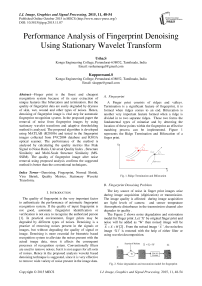Performance Analysis of Fingerprint Denoising Using Stationary Wavelet Transform
Автор: Usha.S, Kuppuswami.S
Журнал: International Journal of Image, Graphics and Signal Processing(IJIGSP) @ijigsp
Статья в выпуске: 11 vol.7, 2015 года.
Бесплатный доступ
Finger print is the finest and cheapest recognition system because of its easy extraction of unique features like bifurcation and termination. But the quality of fingerprint data are easily degraded by dryness of skin, wet, wound and other types of noises. Hence, denoising of fingerprint image is vital step for automatic fingerprint recognition system. In the proposed paper the removal of noise from fingerprint images by using stationary wavelet transform and adaptive thresholding method is analysed. The proposed algorithm is developed using MATLAB (R2010b) and tested in the fingerprint images collected from FVC2004 database and R303A optical scanner. The performance of the method is analysed by calculating the quality metrics like Peak Signal to Noise Ratio, Universal Quality Index , Structure Similarity and Multi-Scale Structure Similarity (MS-SSIM). The quality of fingerprint image after noise removal using proposed analysis confirms the suggested method is better than the conventional techniques.
Denoising, Fingerprint, Normal Shrink, Visu Shrink, Quality Metrics, Stationary Wavelet Transform
Короткий адрес: https://sciup.org/15013926
IDR: 15013926
Текст научной статьи Performance Analysis of Fingerprint Denoising Using Stationary Wavelet Transform
Published Online October 2015 in MECS
The quality of fingerprint is the very important factor to authenticate the performance of automatic fingerprint recognition system. If the quality of input fingerprint is not good, automatic fingerprint identification or verification is not easy to recognize the authorized person [1]. In practical environment, finger prints may be degraded by different types of noises. Denoising is a practice of removing noises present in the signals or images, but without degrading the quality of signal or image. Denoising is more essential for biometric based recognition system to alleviate the noises present with the actual image data, since it affects the consequent processes of recognition system. Conventionally filters are used to remove noises, but it is not augurs for all sorts of noises. Hence in the proposed analysis wavelet based denoising technique is suggested, since it is very effective to remove wide variety of noise present in the image data.
-
A. Fingerprint
A Finger print consists of ridges and valleys. Termination is a significant feature of fingerprint, it is formed when ridges comes to an end. Bifurcation is another very important feature formed when a ridge is divided in to two separate ridges. These two forms the fundamental types of minutiae and by detecting the location of these points within the fingerprint an effective matching process can be implemented. Figure 1 represents the Ridge Termination and Bifurcation of a finger print.
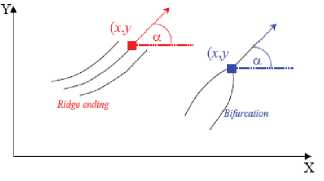
Fig. 1. Ridge Termination and Bifurcation
-
B. Fingerprint Denoising Problem
The key source of noise in finger print images arise during image acquisition (digitization) or transmission. The image quality is affected during image acquisition are light levels of camera and sensor tempeature Atmospheric disturbance in the transmission channel also degrades its quality .
The Figure 2 shows noise degradation and restoration model for finger print .Let ‘X’ be original finger print and n o ise will be added as ‘W’ then noised image will be X = X + W [2] . From the noised image ‘ x \ the noiseless image ‘X1’ is restored with the help of either filter or using wavelet decomposition.
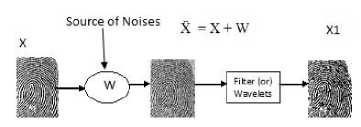
Fig. 2. Noise degradation and restoration model for fingerprint
-
C. Related Work
S. Grace Chang et al. (2000) projected an Adaptive Wavelet Thresholding method for Image Denoising and Compression. Alle Meije Wink et al. (2004) analyses the performance of general wavelet-based denoising scheme with Gaussian Smoothing [3] for Magnetic Resonance Imaging data. H.A.Garcia-Baleon et al. (2009) suggested Wavelet Transform for Cryptographic Key Generation from Bimodal Biometric System [4]. Iman Elyasi et al. (2009) developed an algorithm for Elimination of Noise by Adaptive Wavelet Threshold [5]. Zin Mar Win et al (2011) proposes An Efficient Fingerprint Matching System for Low Quality Images [6]. Dr.E.Chandra et al (2011) given a solution for Noise Elimination in fingerprint image using median filter [7]. Sachin D Ruikar et al. (2011) proposed a method Wavelet Based Image Denoising Technique [8]. Hani M.Ibrahem ( 2014) presented an efficient switching filter based on cubic B-Spline for removal of salt and pepper noise. The author reported with the PSNR value of 50db with 0.2 noise density [9]. C.Nagaraju and S.S Parthasarathy (2015) analyse and estimate the noise in medical images using watermarking method [10].
From the above literature survey the following observations has been made.
The calculated Mean Square Error (MSE) value using BayesShrink threshold method is very less when compared to previous methods available. [11.]
Median filters are good to eradicate the impulse noise in the image. Other types of noises which are present in the image are not removed effectively.
Hence in the proposed analysis to rectify the above problems, denoising of finger print images using Stationary Wavelet Transform (SWT) is suggested.
Section 2 of the paper gives a brief view about standard image denoising methods and summary about the conventional techniques. Section 3 discusses overview of the wavelet transform and SWT. Proposed analysis is discussed in the section 4 and experimental analysis is given in the section 5. Section 6 concludes the performance analysis of the proposed method.
-
II. Standard Image Denoising Methods
Filters are generally used to filter unwanted noise present in the signals and images. The two most popular filters used in the conventional method are median filter and wiener filter.
-
A. Median Filter
y[a,,b,] = median{x[row,col],(row,col) e p} (1)
Where ‘p’ represents a surrounding pixels with center point (a1,b1) in the image.
-
B. Wiener Filter
Wiener filter is a linear Finite Impulse Response (FIR) filter widely used in the reconstruction process of signals and images. By estimating the desired noiseless signal, the filter is able to decrese the amount of noise present in the image.
-
C. Standard Image Quality Metrics
Peak Signal to Noise Ratio (PSNR)
The peak signal-to-noise ratio is defined in equation (2)
PSNR = 10log10(2552/MSE) (2)
where MSE is mean square error.
University quality Index is calculated by calculating Loss of correlation, luminance distortion and contrast distortion. If a = {ai/i = 1,2,....N} and b = {bi/i = 1,2,....N}
‘a’ and ‘b’ be the original and denoised finger print images, then UQI defined as [12] per the equation (3)
QI = 4a a bob/[(a2 2 + a2b)*(a2 + b2 )] (3)
Where
1N 1N a = — OLat • b = — Zb
N t ■ i N t ■
NN
° a = N - 1 1 ; (a i -a) • ’ b 2 = N - 1 1 (b i - b)2
1N
° ab = "TT^t (a i - a)(b i - b) N - 1 i = 1
SSIM compares the structure of original fingerprint images with the denoised image. Formula to calculate the SSIM is [13] is given in the equation (4)
SSIM(a,b) = (2 ^a ^b? + c1)(2aab + c2) (4)
(^ a + ^ b + c 1 )(a a + a b + c 2 )
Where µa, σa and σab represents mean, standard deviations and cross correlation evaluations respectively. c1 and c2 are small constants. Then overall image quality is calculated by measuring MS- SSIM [14] as per the equation (5).
M
MS - SSIM(x,y) = [l M (x,y)] α M. ∏ [c j (x,y)] β j[s j (x,y)] γ j j = 1
-
D. Summary
Both filtering techniques are applied over the 750 fingerprint images collected from FVC2009 database and using scanner R303A. The results of quality metric values for normal, oily and dry fingerprints are given in the tables 1 ,2 and 3.
|
Finger type |
Filter Type |
PSNR |
UQI |
SSIM |
MS-SSIM |
|
Normal |
Median |
57.4807 |
0.6127 |
0.9956 |
0.9994 |
|
Wiener |
56.1556 |
0.5076 |
0.9938 |
0.9992 |
|
|
Oily |
Median |
57.9677 |
0.4408 |
0.9960 |
0.9995 |
|
Wiener |
56.4184 |
0.3561 |
0.9931 |
0.9986 |
|
|
Dry |
Median |
58.1138 |
0.3236 |
0.9970 |
0.9996 |
|
Wiener |
57.8596 |
0.2406 |
0.9922 |
0.9981 |
The table 1 result shows that median filters are better to remove salt and pepper noise.
Table 2. Quality Metrics Calculated after Removing Speckle Noise
|
Finger type |
Filter Type |
PSNR |
UQI |
SSIM |
MS-SSIM |
|
Normal |
Median |
57.5804 |
0.6424 |
0.9938 |
0.9986 |
|
Wiener |
58.3084 |
0.6779 |
0.9939 |
0.9987 |
|
|
Oily |
Median |
57.7083 |
0.5291 |
0.9914 |
0.9978 |
|
Wiener |
57.8044 |
0.5373 |
0.9938 |
0.9986 |
|
|
Dry |
Median |
57.7153 |
0.3728 |
0.9898 |
0.9972 |
|
Wiener |
58.2767 |
0.3929 |
0.9944 |
0.9987 |
Table 2 results coveys that wiener filter is better to remove speckle noise present in all type of finger print images.
Table 3 information conveys that median filter is good to remove gaussian noise present in the normal finger print images but wiener filter is better for oily and dry finger print images.
Table 3. Quality Metrics Calculated after Removing Gaussian Noise
|
Finger type |
Filter Type |
PSNR |
UQI |
SSIM |
MS-SSIM |
|
Normal |
Median |
59.1384 |
0.6651 |
0.9885 |
0.9974 |
|
Wiener |
57.0379 |
0.6370 |
0.9875 |
0.9972 |
|
|
Oily |
Median |
58.1667 |
0.5839 |
0.9928 |
0.9985 |
|
Wiener |
59.0782 |
0.6666 |
0.9938 |
0.9987 |
|
|
Dry |
Median |
60.1580 |
0.5632 |
0.9957 |
0.9992 |
|
Wiener |
61.6329 |
0.6806 |
0.9965 |
0.9993 |
The above results prove that particular filter is effective to remove only specific type of noise. But in real time environment need a better algorithm which should be suitable to remove all types of noise present in the fingerprint. For which wavelet based denoising technique is better than the conventional technique.
-
III. Overview of Wavelets
A wavelet is a localized function that can be used to capture informative efficient and useful information of signals. Wavelet transform (WT) used to represent an image is a sum of wavelets with different resolution levels [15]. At high frequencies WT provides good time resolution, whereas at low frequencies it provides good frequency resolution. Hence both time and frequency analysis of signals can be done using wavelets [16].
-
A. Wavelet Decomposition
Initially, the image of size N x N is low and high pass filtered along the rows and the outcomes of the each filter are down- sampled by two. Again each of these subsignals are high and low pass filtered along the columns and the outcomes of the each filter are downsampled by two [16]. As a result the original images is divided into four subbands each of size N/2 x N/2 containing information from different frequency components. After wavelet decomposition the image will split into four sub band as shown in the Figure 3.
|
LLJ |
.H2 |
LH1 |
|
|
HL2 |
HH3 |
||
|
HL2 |
HH2 |
||
|
HL* |
HH1 |
||
Fig. 3. Sub-bands of the 2-D orthogonal Wavelet Transform
Where
LLn – nth level decomposition contains low frequency components also called as approximation subband.
LHn- nth level decomposition contains low and high frequency components contains vertical detail information
HLn- nth level decomposition contains high and low frequency components contains horizontal detail information.
HHn – nth level decomposition contains high frequency components obtained by high pass filtering in both the directions
-
B. Wavelet Families
There are various basis functions of wavelets are available in the literature among which the most popular families are Daubechis, coiflets and Symlets. Daubechis wavelets are families of orthogonal wavelets defining a Discrete Wavelet Transform (DWT). With each wavelet types of this class, there is a scaling function which generates multiresolution analysis. Coiflets are popular in
DSP applications due to their sampling approximation property and their associated near linear –phase filter banks. Symlets are more symmetric than external phase wavelets and are also known as Daubechis least asymmetric wavelets.
-
C. Stationary Wavelet Transform
In this paper SWT is used to reduce the noise level present in the finger print images. The shift invariant property of this transform is the main reason to choose SWT for proposed wavelet analysis to remove noise whereas Discrete Wavelet Transform is shift variant.
The SWT is a wavelet transform algorithm designed to improve the lack of translation –invariance of the Discrete Wavelet Transform (DWT). The Translationinvariance characteristics of SWT are achieved by removing up samplers and down samplers present in the DWT . To obtain coefficients for jth level, the filter coefficients are up sampled by a factor of 2(j - 1). Since SWT is a redundant scheme , the number of samples present in the output of each level is same as that of number of samples present in the input. So, for N level decomposition, there is a of possibility of N redundant wavelet coefficients. The three level decomposition filter structure is shown in the Figure 4.
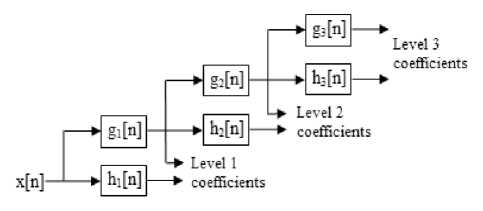
Fig. 4. Three level SWT filter bank
Filters used in SWT in each level are up-sampled version of the previous level is shown in the figure 5.

Fig. 5. Filters used in SWT
Denoising through Stationary wavelet transform [17] has three steps:
-
(i) Wavelet transform is applied over the noisy image and the corresponding wavelet coefficients are obtained.
-
(ii) Adaptive thresholding like Normal shrink, Visu Shrink etc. are applied over the wavelet coefficients.
-
(iii) Original denoised image is retrieved by applying Inverse Transform over the wavelet coefficients obtained in the second step.
The stationary Wavelet Families used in the proposed analysis are: Daubechies Wavelet, Symlets and Coiflets .
-
IV. SWT Based Denoising
In this section the structure of the SWT based denoising for fingerprint image process and various thresholding function used for denoising are discussed. The proposed block diagram for removing noise from the finger print image is shown in the Figure 6.

Fig. 6. Block diagram of proposed analysis
The given input fingerprint image is binarized and decomposed using SWT. For, the obtained image threshold value is calculated using Visushrink threshold and Normal shrink method. Reconstruction is done through ISWT with the new coefficients obtained through threshold.
-
A. Image Binarization
Image binarization is the process of converting a grayscale image into binary format based on a threshold value. Choosing correct threshold value is a very important factor. Since very low threshold value causes the resulting image with more white pixels, and very high threshold value makes the resulting image comprising of more undesired black pixels. Thus, the threshold must be selected carefully to ensure the data information is preserved after the binarization [4]. In the proposed method greythreshold level available in the MATLAB toolbox was chosen for analysis.
-
B. Decomposing through SWT
SWT decomposition [5] is done using the wavelet families like Daubechies (dbN), or Symlet (symN) or Coiflets (coifN) [1] to the randomly selected 50 images from both the databases to analyse which produces better result. The analysis gives db4, coif2 and sym4 gives better performance when compared to other forms. Hence, these three wavelets are chosen for analysis purpose. The Figure 6 shows the SWT Decomposition using db4.
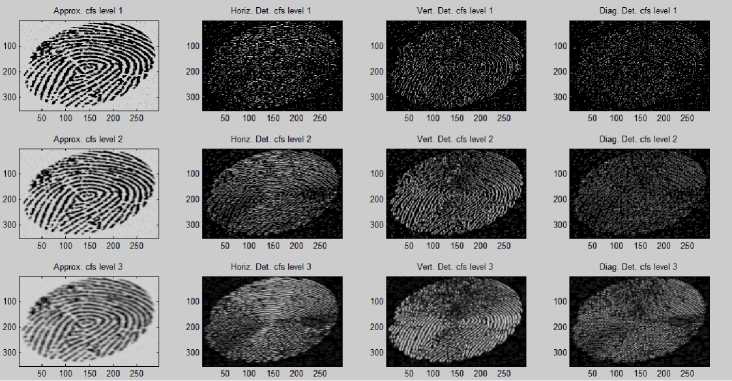
Fig. 7. SWT Decomposition Using db4
Figure 7, result conveys that level 2 decomposition produces the better result, above which the image quality is degraded. So, SWT with level 2 decomposition is suggested.
Wavelet thresholding is a signal estimation technique that exploits the capabilities of wavelet transform for signal denoising. It removes noise by killing coefficients that are insignificant . The threshold value is calculated from detailed coefficients obtained from image to be denoised. For the proposed work Visu Shrink and Normal shrink threshoding methods are used for analysis purpose.
Visu shrink is a hard threshold method. The threshold value ‘t’ here is in proportion with the standard deviation of the noise [6]. VisuShrink does not deal with minimizing the mean squared error. It can be viewed as general-purpose threshold selectors that exhibit near optimal min-max error properties and ensures with high probability that the estimates are as smooth as the true underlying functions. VisuShrink follows the global thresholding scheme where there is a single value of threshold applied globally to all the wavelet coefficients.
The formula for calculating the threshold value is: [18]
T = од/ 2logM (6)
ст = NoiseVariance
M = Image length medianf Wk |: k = 1,2,....n} о =--------------------
0.6745
Wk=Detail coefficients at the finest level
The optimum threshold value for the Normal Shrink (TN) is given by [18]
X =
ov2=Noise Variance oy =Signal Variance without Noise
Lk- is length of the sub band at kth scale.
J -is the total number of decompositions
-
C. Reconstruction through ISWT
The reconstructed image is obtained from multilevel decomposed coefficients of an image. Reconstruct the image done through Inverse Stationary Wavelet Transform uses the same wavelet family function which is used for decomposition. The Figure 8 shows the image reconstruction using db4 and Normal shrink threshold method.
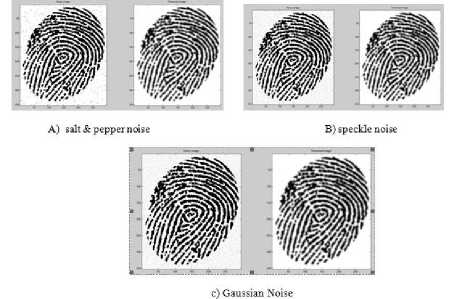
Fig. 8. Image Reconstruction using ISWT
The Figure 8 a) shows the reconstructed fingerprint image after removing salt and pepper noise 8b and 8c denotes reconstructed fingerprint image after removing speckle and Gaussian noises respectively.
T = ^L
σy
V. Simulation Results
The calculated quality metric result for one fingerprint image of each type (normal, dry and oily) shows that db4 wavelet using normal shrink method is effective than coif2 and sym4 to remove all types of noise present in the finger print images. To verify the result the same algorithm is applied over FVC2004 database (100 images) and R303A database (100 images). Then overall quality metrics (PSNR, UQI, SSIM, MS-SSIM) value is calculated by taking average value. In the following figures the blue line indicates the evaluated performance metric using db4 wavelets and red colour indicates coiflets, whereas the green colour indicates the symlet wavelet performance.
-
A. Peak Signal to Noise Ratio (PSNR)
The calculated PSNR value for FVC2004 database is and for R303A database is shown in the Figure 9.
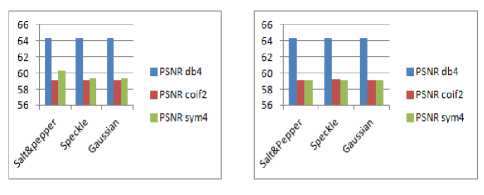
Fig. 9. PSNR for FVC2004 and R303A.
The figure 9 results shows that the PSNR value for denoising using db4 wavelet is 64db whereas for coif2 and sym4 wavelets are 59db. This results infers that db4 wavelet transform provides better PSNR ratio when compared to coif2 and sym4 wavelet transform.
-
B. Universal Quality Index (UQI)
Universal Quality Index provides a better quality measure when compared to conventional error summation method. Figure 10 shows the calculated UQI values for denoised fingerprints.
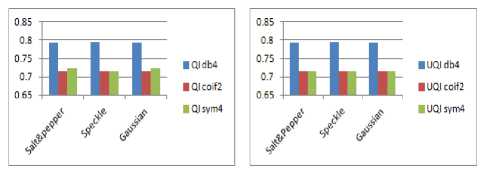
Fig. 10. UQI for FVC2004 and R303A
The results projected gives the information that the UQI for recovered fingerprint is 0.79 in the case of da4 and 0.72 in the case of coif2 and sym4 wavelets shows that the db4 wavelet produces better result in the case of fingerprint denoising applications.
-
C. Structural Similarity Index (SSIM)
SSIM compares the local luminance, contrast and structure between original and noisy images. Figure 11
refers the calculated SSIM for FVC2004 and for R303A database.
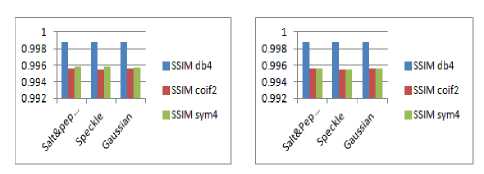
Fig. 11. SSIM for FVC2004 and R303A
The demonstrated results shows that the SSIM value for denoised fingerprint is 0.9987 in the case of db4 wavelet transform, 0.9956 in the case of coif2 and sym4 wavelets. This results shows that db4 provides better SSIM metric value for removing all three types of noises present in the fingerprint images when compared to coif2 and sym4 wavelets.
-
D. Multi Scale Structural Similarity (MS-SSIM)
For variations in viewing conditions, Multi Scale structural similarity index gives more flexibility than SSIM. Figure 12 shows the calculated MS-SSIM values for FVC 2004 and R303A fingerprint images.
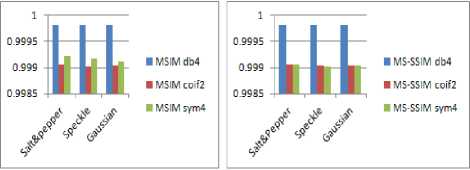
Fig. 12. MS-SSIM for FVC2004 and for R303A
The above experimental results shows that the calculated MS-SSIM using db4 wavelet is 0.9998 and coif2 and sym4 wavelets are 0.9991. This results illustrates that db4 provide better MS-SSIM metric value for biometric denoising problem when compared to coif2 and sym4 wavelets.
-
VI. Conclusion
The fingerprint images collected from FVC2004 database and R303A scanner are contaminated with source of noises. Then stationary wavelet transform with adaptive thresholding method is applied over the noisy fingerprint image to obtain detailed wavelet coefficients. Then inverse transform is applied to get the noiseless fingerprint image. The quality of the denoised image is measured by calculating PSNR value in decibels, Universal Quality Index, SSIM and MS-SSIM The Experimental results shows that db4 wavelet transform using Normal shrink produces better quality metrics for all types of noises when compared to coif2 and sym4 wavelet transform. The table 4 shows the comparison results of conventional method and proposed analysis.
Table 4. Comparative Analysis of Conventional and Proposed Methods
|
Method |
Noise |
PSNR |
UQI |
SSIM |
MS-SSIM |
|
Filters |
Salt &Pepper |
57.3326 |
0.4136 |
0.9946 |
0.9991 |
|
Speckle |
57.8989 |
0.5254 |
0.9929 |
0.9983 |
|
|
Gaussian |
59.2020 |
0.6327 |
0.9925 |
0.9984 |
|
|
Db4 Wavelet |
Salt &Pepper |
64.2980 |
0.7930 |
0.9987 |
0.9998 |
|
Speckle |
64.2980 |
0.7930 |
0.9987 |
0.9998 |
|
|
Gaussian |
64.2980 |
0.7930 |
0.9987 |
0.9998 |
From the above table 4 result confirms that the proposed wavelet analysis not only remove all types of noise present in the finger print images but also provide better quality metrics like PSNR, UQI, SSIM and MS-SSIM than conventional method . In future, the biometric analysis of denoised fingerprint has to be done.
Список литературы Performance Analysis of Fingerprint Denoising Using Stationary Wavelet Transform
- S.S . Gornale , V. Humbe, R. Manza and K. Kale, " Fingerprint image de-noising using multiresolution analysis through SWT method", International Journal of Knowledge Engineering, vol. 1, no. 1, pp.05-14, 2010.
- Zin Mar Win and Myint Myint Sein, "An Efficient Finger Print Matching System for Low Quality Images", International Journal of Computer Applications, vol. 26, no. 4, pp. 5-12, 2011.
- Alle Meije Wink and Jos B.T.M.Roerdink, "Denoising Functional MR Images; A Comparison of Wavelet Denoising And Gaussian Smoothing", IEEE Transactions on Medical Imaging, vol. 23, no.3, pp.374-387, 2004.
- H.A Garcia-Baleon, V. Alarcon-Aquino, and J. F Ramirez-Cruz, "Bimodal Biometric System for Cryptographic Key Generation Using Wavelet Transforms", in Proceedings of the IEEE Mexican International Conference on Computer Science, ENC 2009, Sep. 2009.
- Jean-Luc Stark, Jalal Fadili and Fionn Murtagh "The Undecimated Wavelet Decomposition and its Reconstruction", IEEE Transactions on Image Processing, vol 16, no 2, pp 297-309.
- Iman Elyasi, and Sadegh Zarmehi," Elimination Noise by Adaptive Wavelet Threshold", World Academy of Science, Engineering and Technology 56 2009, pp.462-466.
- E. Chandra and K.Kanagalakshmi, "Noise Elimination in Fingerprint Image Using Median Filter", International Journal on Advanced Networking and Applications, vol. 2, no. 06, pp.950-955, 2011.
- M.Raghuveer Rao, and A.S. Bopardikar, "Wavelet Transforms: Introduction to Theory and application", Addison-Wesley, pp 1-126, 2001.
- Hani.M.Ibrahem, " An efficient switching filter based on cubic B-spline for removal of salt and pepper noise ", International Journal of Image, Graphics and Signal Processing ,vol.6, no.5, pp.45-52, 2014.
- Nagaraju and S.S.Parthasarathy, "Analysis and estimation of noise in embedded medical images", International Journal of Image, Graphics and Signal Processing, vol.7, no.3, pp.45-50, 2015.
- S. Grace Chang, Bin Yu and Martin Vetterli "Adaptive Wavelet Thresholding for Image Denoising and Compression", IEEE transactions on Image Processing, vol. 9, no 9, pp. 1532-1546, 2000.
- Zhou Wang and Alan C. Bovik, "A Universal Image Quality Index", IEEE Signal Processing Letters, vol. 9, no. 3, pp. 81-84, 2002.
- Zhou Wang, Alan C. Bovik, Hamid R. Sheikh and Eero P. Simoncelli " Image Quality Assessment : From Error Visibility to structural similarity", IEEE Transaction Image Processing, vol .13, no 4, pp 1-14, 2004.
- Zhou Wang, Eero P.Simoncelli and Alan C.Bovik, "Multi-Scale Structural Similarity For Image Quality Assessment', Proceedings of 37th IEEEAsilomar Conference on Signals,Systems and Computers",Pacific Grove, Nov 9-12,2003.
- Sachin D Ruikar, Dharmpal D Doye, "Wavelet Based Image Denoising Technique', International Journal of Advanced Computer Science and Applications, vol. 2, no.3, pp 49-53, 2011.
- Arun Dixit and Poonam Sharma, " A Comparative study of wavelet thresholoding for image denoising", Internation Journal of Image, Graphics and Signal Processing ,vol.6 no.12, pp.39-46, 2014.
- A.K.Jain, H.Lin, S.Pankanti and R.Bolle., " An Identity Authentication System Using Fingerprints", Proceedings of the IEEE, vol. 85, no. 9, 1997.
- D.L Donoho and I.M. Johnstone, "Denoising by Soft Thresholding", IEEE Transaction on Information Theory, vol.41, 1995, pp 613-627.

